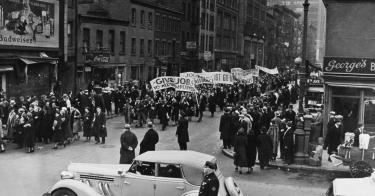Much of the current debate over policy surrounding the coronavirus pandemic centers on thorny questions over how and when to reopen certain businesses. But there’s a larger debate underway—one that focuses on what’s around the economic corner for the country after COVID-19.
Now that we’re facing unemployment figures that rival even the Great Depression, it’s no surprise that some pundits are urging a return to the policies of President Franklin Roosevelt.
It’s right to be worried about the economic plight of ordinary Americans. But is a “new New Deal,” as some are clamoring for, the right solution? Is today’s economic crisis even the same thing as the Great Depression?
The Great Depression that began in October 1929 was a systemic collapse through every sector of the U.S. economy, and the economies of most of the world’s nations. The root causes of the collapse have long been debated. Monetary policy and a weak banking system certainly contributed, as did the loss of so many of America’s young people to World War I. The war’s demographic blows wiped out a significant portion of a generation that, in 1929, would just have been coming into its prime as producers and consumers.
This is far different from what we are encountering today, which is largely the result of government policies in response to a public health crisis that forced many businesses to close. While the COVID-19 response certainly exposed some underlying weaknesses in our economy, America’s overall economic health coming into 2020 seemed to be strong.
Our economic crisis is serious, but it is concentrated overwhelmingly in one sector—leisure and hospitality. Moreover, the unemployment it has triggered is disproportionately centered in just seven states. We are not, in other words, talking about a systemic collapse on the order of 1929.
But the larger question is whether the call for a new New Deal would actually be the cure, and the answer we give to that depends on whether the New Deal was in fact the cure for the Great Depression. There is as little consensus among historians about that as about the causes of the Depression.
The New Deal saw a dramatic increase in federal spending occur, more or less tripling the federal budget and the federal government’s percentage of GDP. But what did it produce? The results were negligible. Federal deficits increased dramatically. But personal welfare, as measured by receipts from personal income taxes and nonagricultural employment numbers, showed only modest corresponding benefit.
Federal revenue from income taxes stood at just over $1 billion in 1929; that figure dropped precipitously by 1933 to approximately a third of its 1929 level, and only recovered by 1936 to a point 61% of what it had been four years before. In fact, personal income, as measured by the income tax revenue figures, did not begin to approach its 1929 levels until 1940 and the onset of World War II in Europe, when spending on war-related production began to soar.
This arc downward is reflected in the non-agricultural employment figures. Employment in these sectors in 1936 was still only 89% of what it had been in 1929, and never recovered to 1929 levels until 1940 and the movement to war-related production.
There remain many unknowns in the murky atmosphere of COVID-19. But one answer will surely not lead us there, and that is to lock down individuals and businesses indefinitely, with the expectation that the expiration of their jobs and livelihoods can be made up by federal government largesse. The safest way back to normal is to normalize, but to do so as wisely and with as much attention to specific areas and needs as possible.
As we look at this new economic crisis, we need to take the advice of an earlier president, facing an earlier and much more formidable crisis: Abraham Lincoln, in the Civil War. “As our case is new, so we must think anew, and act anew. We must disenthrall ourselves, and then we shall save our country.”
This piece originally appeared in the Chicago Tribune



